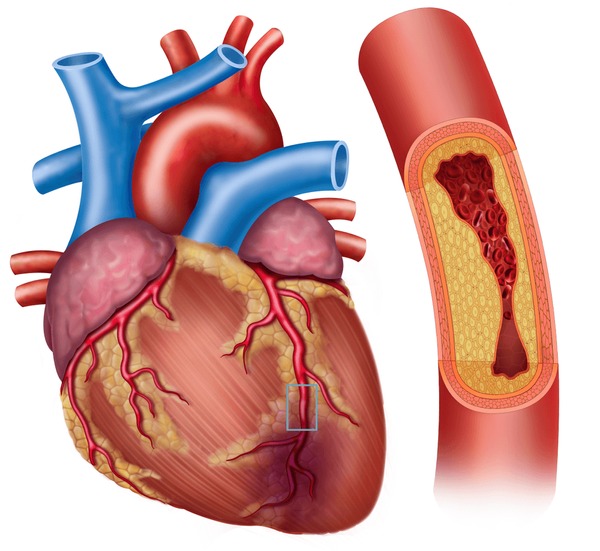
Adelekan Oluwaseun Ojo.
What is coronary artery disease?
Coronary artery disease (CAD) is a narrowing or blockage of your coronary arteries, which supply oxygen-rich blood to your heart. This happens because, over time, plaque (including cholesterol) builds up in these arteries and limits how much blood can reach your heart muscle.
Picture two traffic lanes that merge into one due to construction. Traffic keeps flowing, just more slowly. With CAD, you might not notice anything is wrong until the plaque triggers a blood clot. The blood clot is like a concrete barrier in the middle of the road. Traffic stops. Similarly, blood can’t reach your heart, and this causes a heart attack.
You might have CAD for many years and not have any symptoms until you experience a heart attack. That’s why CAD is a “silent killer.”
Other names for CAD include coronary heart disease (CHD) and ischemic heart disease. It’s also what most people mean when they use the general term “heart disease.”
Coronary artery disease types
There are two main forms of coronary artery disease:
- Stable ischemic heart disease: This is the chronic form. Your coronary arteries gradually narrow over many years. Over time, your heart receives less oxygen-rich blood. You may feel some symptoms, but you’re able to live with the condition day to day.
- Acute coronary syndrome: This is the sudden form that’s a medical emergency. The plaque in your coronary artery suddenly ruptures and forms a blood clot that blocks blood flow to your heart. This abrupt blockage causes a heart attack.
Symptoms and Causes.
What are the symptoms?
You may have no symptoms of coronary artery disease for a long time. Plaque buildup takes many years, even decades. But as your arteries narrow, you may notice mild symptoms. These symptoms mean your heart is pumping harder to deliver oxygen-rich blood to your body.
Symptoms of chronic CAD include:
Stable angina: This is the most common symptom. Stable angina is temporary chest pain or discomfort that comes and goes in a predictable pattern. You’ll usually notice it during physical activity or emotional distress. It goes away when you rest or take nitroglycerin (medicine that treats angina).
Shortness of breath (dyspnea): Some people feel short of breath during light physical activity.
Sometimes, the first coronary artery disease symptom is a heart attack.
What causes coronary artery disease?
Atherosclerosis causes coronary artery disease. Atherosclerosis is the gradual buildup of plaque in arteries throughout your body. When the plaque affects blood flow in your coronary arteries, you have coronary artery disease.
Plaque consists of cholesterol, waste products, calcium and fibrin (a substance that helps your blood clot). As plaque collects along your artery walls, your arteries become narrow and stiff.
Plaque can clog or damage your arteries, which limits or stops blood flow to a certain part of your body. When plaque builds up in your coronary arteries, your heart muscle can’t receive enough blood. So, your heart can’t get the oxygen and nutrients it needs to work properly (myocardial ischemia). It leads to chest discomfort (angina) and puts you at risk of a heart attack.
People who have plaque buildup in their coronary arteries often have buildup elsewhere in their body, too. This can lead to conditions like carotid artery disease and peripheral artery disease (PAD).
Is it genetic?
Partly. Family history affects your risk of coronary artery disease, but many other risk factors have nothing to do with your genetics. The choices you make every day add up to a big impact on your risk of CAD.
What are the risk factors for coronary artery disease?
There are many risk factors for coronary artery disease. You can’t change all of them, but you can manage some of them by making lifestyle changes or taking medications. Talk with your provider about what you can do about these risk factors:
- Being older than 45 if you’re assigned male at birth (AMAB) or over 55 if you’re assigned female at birth (AFAB).
- Having a biological family member with heart disease, especially a father or brother with a diagnosis before age 55 or mother or sister before age 65.
- Eating a lot of saturated fat or refined carbohydrates.
- Not exercising enough.
- Not getting enough sleep.
- Smoking, vaping or other tobacco use.
- Having atherosclerosis.
- High blood pressure.
- High LDL (“bad”) cholesterol.
- Low HDL (“good”) cholesterol.
- High triglycerides (hypertriglyceridemia).
- Anemia.
- Autoimmune diseases, including lupus and rheumatoid arthritis.
- Chronic kidney disease.
- Diabetes.
- HIV/AIDS.
- Metabolic syndrome.
- A body mass index (BMI) higher than 25.
- Sleep disorders like sleep apnea.
- Early menopause (before age 40).
- Endometriosis.
- History of gestational diabetes, eclampsia or preeclampsia.
- Use of hormonal birth control.
What are the complications of coronary artery disease?
The main complication of coronary artery disease is a heart attack. This is a medical emergency that can be fatal. Your heart muscle starts to die because it’s not receiving enough blood. You need prompt medical attention to restore blood flow to your heart and save your life.
Over the years, CAD can also weaken your heart and lead to complications, including:
- Arrhythmias (abnormal heart rhythms like atrial fibrillation).
- Cardiac arrest.
- Cardiogenic shock.
- Heart failure.
Management And Treatment
How is coronary artery disease treated?
Coronary artery disease treatment often includes lifestyle changes, risk factor management and medications. Some people may also need a procedure or surgery.
Your healthcare consultant will talk with you about the best treatment plan for you. It’s important to follow your treatment plan so you can lower your risk of serious complications from CAD.
Lifestyle changes
Lifestyle changes play a big role in treating coronary artery disease. Such changes include:
- Don’t smoke, vape or use any tobacco products.
- Eat heart-healthy foods low in sodium, saturated fat, trans fat and sugar. The Mediterranean diet is a proven way to lower your risk of a heart attack or stroke.
- Exercise: Aim for 30 minutes of walking (or other activities) five days a week.
- Limit alcohol.
Be sure to talk with your provider before starting any new exercise program. Your provider can also offer guidance on lifestyle changes tailored to your needs. They may recommend smoking cessation options or meeting with a dietitian to discuss healthy eating plans.
Risk factor management
Managing your risk factors for CAD can help slow down the progression of your disease. Work with your provider to manage the following conditions:
- Diabetes.
- High blood pressure.
- High cholesterol.
- High triglycerides (hypertriglyceridemia).
- Having a BMI higher than 25.
Medications
Medications can help you manage your risk factors and treat symptoms of coronary artery disease. Your provider may prescribe one or more medications that:
- Lower your blood pressure.
- Lower your cholesterol.
- Manage stable angina, like nitroglycerin and ranolazine.
- Reduce your risk of blood clots.
Procedures and surgeries
Some people need a procedure or surgery to manage coronary artery disease, including:
- Percutaneous coronary intervention (PCI): This minimally invasive procedure has another name — coronary angioplasty. Your provider reopens your blocked artery to help blood flow through it better. They may also insert a stent to help your artery stay open.
- Coronary artery bypass grafting (CABG): This surgery creates a new path for your blood to flow around blockages. This “detour” restores blood flow to your heart. CABG helps people who have severe blockages in several coronary arteries.
Complications/side effects of the treatment
Complications or side effects of coronary artery disease treatments may include:
Bleeding.
Diarrhea.
Dizziness.
Cough.
Blood clot.
Coronary artery puncture.
Infection.
Abnormal heart rhythms.
Cardiac tamponade.
How long does it take to recover from this treatment?
After PCI (angioplasty), you can usually get back to normal activities within a week. After CABG (bypass surgery), you’ll be in the hospital for more than a week. After that, it’ll take six to 12 weeks for a full recovery.
Prevention
Can coronary artery disease be prevented?
You can’t always prevent coronary artery disease because some risk factors are out of your control. But you can lower your risk of coronary artery disease and help prevent it from getting worse in these ways:
Commit to quitting smoking and all tobacco use.
Eat heart-healthy foods.
Get enough sleep.
Stay at a weight that’s healthy for you.
Learn your risk for heart disease.
Limit alcohol use.
Move around more.
Keep taking your medications.
STAY HEALTHY ALWAYS!
…..……………………Adelekan Oluwaseun Ojo, is a counseling psychologist, and a business & health consultant with Jigsimur Zdex Int’l, a company which is into the production and distribution of Jigsimur herbal health drink, a natural curative and preventive herbal medicine from South Africa.
For personal consultation, you can contact us on 07089225319 or 08035122399





